|
|
|

|
|
2015 (vol. 15)
|
|
A review of the species of the genus Hemidiadema Agassiz, 1846 (Euechinoidea, Camaradonta, Glyphocyphidae), from the Aptian (Lower Cretaceous) of Spain
Arnaud CLÉMENT
| HTML  | PDF
| PDF  [2,717 KB]
| DOI:
10.4267/2042/58204
[2,717 KB]
| DOI:
10.4267/2042/58204
|
|
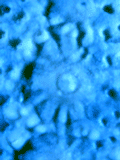 Abstract:
Specimens belonging to the genus Hemidiadema Agassiz, 1846, from Aptian (Lower Cretaceous) strata from the Spanish provinces of Castellón, Tarragona, Barcelona and Teruel –were studied. All specimens of Hemidiadema from these regions cited or described in the literature until now were related to the species Hemidiadema rugosum Agassiz, 1846. Their taxonomic revision – based on historical material and new collecting – demonstrates that these individuals do not belong to the species described by Agassiz, but represent new taxa. Three new species are proposed and described: Hemidiadema batalleri nov. sp., H. malladai nov. sp., and H. forcallensis nov. sp). The species H. rugosum Agassiz, 1846, is known by a single specimen from the Aptian of Castellón. Remarks on the paleoecology and stratigraphic and geographic distributions of these species are given. Abstract:
Specimens belonging to the genus Hemidiadema Agassiz, 1846, from Aptian (Lower Cretaceous) strata from the Spanish provinces of Castellón, Tarragona, Barcelona and Teruel –were studied. All specimens of Hemidiadema from these regions cited or described in the literature until now were related to the species Hemidiadema rugosum Agassiz, 1846. Their taxonomic revision – based on historical material and new collecting – demonstrates that these individuals do not belong to the species described by Agassiz, but represent new taxa. Three new species are proposed and described: Hemidiadema batalleri nov. sp., H. malladai nov. sp., and H. forcallensis nov. sp). The species H. rugosum Agassiz, 1846, is known by a single specimen from the Aptian of Castellón. Remarks on the paleoecology and stratigraphic and geographic distributions of these species are given.
|
|
Carnets Geol., vol. 15, no. 20, p. 279-330
Online since December 25, 2015
|
|
Distribution of Conichnus and Amphorichnus in the Lower Paleozoic of Estonia (Baltica)
Olev VINN, Mark A. WILSON & Ursula TOOM
| HTML  | PDF
| PDF  [1,137 KB]
| DOI:
10.4267/2042/58180
[1,137 KB]
| DOI:
10.4267/2042/58180
|
|
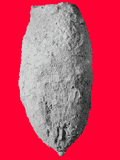 Abstract:
Conichnus conicus and Amphorichnus papillatus occur in clay-rich carbonate rocks in the Ordovician of Estonia.
Conichnus conicus also occurs in clay-rich carbonates of the early Silurian of Estonia. Lateral adjustment traces are more common in C. conicus than previously recorded. The lack of adjustment traces in Amphorichnus, together with its morphology, does not support synonymy of Conichnus and Amphorichnus. The
Conichnus conicus and Amphorichnus papillatus tracemakers preferred shallow water carbonate environments with high clay content. They were rare or did not occur in deeper water muddy environments or where shallow water carbonates accumulated. A high content of volcanic ash in the depositional environment is characteristic of both the Ordovician and Silurian maxima of
Conichnus conicus occurrence. C. conicus may have been more common in the temperate seas of Baltica than in the tropics. Abstract:
Conichnus conicus and Amphorichnus papillatus occur in clay-rich carbonate rocks in the Ordovician of Estonia.
Conichnus conicus also occurs in clay-rich carbonates of the early Silurian of Estonia. Lateral adjustment traces are more common in C. conicus than previously recorded. The lack of adjustment traces in Amphorichnus, together with its morphology, does not support synonymy of Conichnus and Amphorichnus. The
Conichnus conicus and Amphorichnus papillatus tracemakers preferred shallow water carbonate environments with high clay content. They were rare or did not occur in deeper water muddy environments or where shallow water carbonates accumulated. A high content of volcanic ash in the depositional environment is characteristic of both the Ordovician and Silurian maxima of
Conichnus conicus occurrence. C. conicus may have been more common in the temperate seas of Baltica than in the tropics.
|
|
Carnets Geol., vol. 15, no. 19, p. 269-278
Online since December 2, 2015
|
|
Selected agglutinated larger foraminifera from the Font de les Bagasses unit (early Campanian, southern Pyrenees)
Sergi ALBRICH, Carme BOIX & Esmeralda CAUS
| HTML  | PDF
| PDF  [5,455 KB]
| DOI:
10.4267/2042/57953
[5,455 KB]
| DOI:
10.4267/2042/57953
|
|
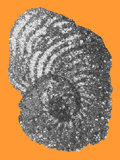 Abstract:
The Font de les Bagasses marls and marly limestones (Montsec Mountains, NE Spain) host a rich assemblage of larger foraminifera, that was described for the first time in the early 20th Century from the currently submerged locality of Tragó de Noguera (Marginal Mountains). In this paper, a detailed architectural study has been carried out on selected, agglutinated larger foraminifera, which
include Choffatella aff. rugoretis Gendrot, Hemicyclammina chalmasi (Schlumberger), Cuneolina conica
Orbigny, Cuneolina cylindrica Henson,
and Dictyopsella kiliani Munier-Chalmas. Moreover, it presents their biostratigraphic range and the range of the associated
porcellaneous and lamellar-perforate foraminifera in the study area. The
assemblage is Early Campanian in age. Abstract:
The Font de les Bagasses marls and marly limestones (Montsec Mountains, NE Spain) host a rich assemblage of larger foraminifera, that was described for the first time in the early 20th Century from the currently submerged locality of Tragó de Noguera (Marginal Mountains). In this paper, a detailed architectural study has been carried out on selected, agglutinated larger foraminifera, which
include Choffatella aff. rugoretis Gendrot, Hemicyclammina chalmasi (Schlumberger), Cuneolina conica
Orbigny, Cuneolina cylindrica Henson,
and Dictyopsella kiliani Munier-Chalmas. Moreover, it presents their biostratigraphic range and the range of the associated
porcellaneous and lamellar-perforate foraminifera in the study area. The
assemblage is Early Campanian in age.
|
|
Carnets Geol., vol. 15, no. 18, p. 245-267
Online since November 18, 2015
|
|
Tremichnus in crinoid pluricolumnals from the Silurian of western Estonia (Baltica)
Olev VINN, Mark A. WILSON, William I. AUSICH & Ursula TOOM
| HTML  | PDF
| PDF  [644 KB]
| DOI:
10.4267/2042/57951
[644 KB]
| DOI:
10.4267/2042/57951
|
|
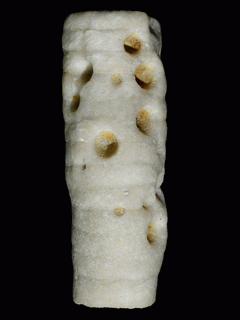 Abstract:
Quelques petites cavités attribuées à Tremichnus ont été trouvées dans des
crinoïdes provenant du Silurien d'Estonie. Ce Tremichnus
rhuddanien est le symbiote le plus ancien observé dans des segments
de tiges de crinoïdes du bouclier balte. Ces cavités correspondent
vraisemblablement à des habitats d'organismes inconnus. Tremichnus
a eu un impact négatif sur le crinoïde hôte comme en attestent
les renflements des tiges. Tremichnus est moins fréquent
dans le Silurien d'Estonie que des traces semblables dans le
Silurien du Gotland voisin. L'aspect le plus significatif de cette
étude est la rareté de cette interaction dans ces échantillons à
la différence de la plupart des échantillons du même âge
provenant d'autres localités. Ces structures ont une répartition très irrégulière. Abstract:
Quelques petites cavités attribuées à Tremichnus ont été trouvées dans des
crinoïdes provenant du Silurien d'Estonie. Ce Tremichnus
rhuddanien est le symbiote le plus ancien observé dans des segments
de tiges de crinoïdes du bouclier balte. Ces cavités correspondent
vraisemblablement à des habitats d'organismes inconnus. Tremichnus
a eu un impact négatif sur le crinoïde hôte comme en attestent
les renflements des tiges. Tremichnus est moins fréquent
dans le Silurien d'Estonie que des traces semblables dans le
Silurien du Gotland voisin. L'aspect le plus significatif de cette
étude est la rareté de cette interaction dans ces échantillons à
la différence de la plupart des échantillons du même âge
provenant d'autres localités. Ces structures ont une répartition très irrégulière.
|
|
Carnets Geol., vol. 15, no. 17, p. 239-243
Online since November 18, 2015
|
|
Scientific death-knell against databases? Errors induced by database manipulations and its consequences
Christian C. EMIG, Maria Aleksandra BITNER & Fernando ÁLVAREZ
| HTML  | PDF
| PDF  [107 KB]
| DOI:
10.4267/2042/57949
[107 KB]
| DOI:
10.4267/2042/57949
|
|
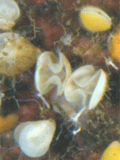 Abstract:
References to Terebratulina caputserpentis attributing its authorship to Zbyszewski, 1957, not to Linnæus, 1767, have been found in three recent publications, in the collections of the Muséum National d'Histoire naturelle de Paris and in several
online databases. The use in these databases seems to have arisen from WoRMS (World Register of Marine Species), specifically from WBD (World Brachiopoda Database) of which the three authors of this paper are the editors (authors). The page concerning T. caputserpentis (Linnæus, 1767) has been modified by WoRMS staff without the knowledge of these editors (authors). Abstract:
References to Terebratulina caputserpentis attributing its authorship to Zbyszewski, 1957, not to Linnæus, 1767, have been found in three recent publications, in the collections of the Muséum National d'Histoire naturelle de Paris and in several
online databases. The use in these databases seems to have arisen from WoRMS (World Register of Marine Species), specifically from WBD (World Brachiopoda Database) of which the three authors of this paper are the editors (authors). The page concerning T. caputserpentis (Linnæus, 1767) has been modified by WoRMS staff without the knowledge of these editors (authors).
The decrease of the specialists in systematics and their replacement by IT specialists question the scientific reliability of the online databases as well as the specimen labelling in museums. The absence of scientific rigour becomes their Achilles' heel. Several other cases of errors are quoted and developed. In spite of applications to the staff of databases in biodiversity, the situation continued degrading so much so that today these bases are reached by the Peter principle and can no longer be used for scientific requirements, except if verifying all the desired data.
|
|
Carnets Geol., vol. 15, no. 16, p. 231-238
Online since November 11, 2015
|
|
New fossiliferous sites with Barremian Charophyta in the "Grès du Liban" auct. (Lebanon), with a critical perspective regarding the nature of Munieria Deecke, 1883
Bruno GRANIER, Dany AZAR, Sibelle MAKSOUD, Raymond GÈZE & Roland HABCHI
| HTML  | PDF
| PDF  [5,904 KB]
| DOI:
10.4267/2042/57947
[5,904 KB]
| DOI:
10.4267/2042/57947
|
|
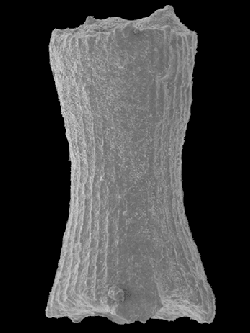 Abstract:
The "Grès du
Liban" auct. is the thick basal unit of the Lower Cretaceous series in Lebanon.
There are two key
levels in this dominantly siliciclastic unit: the "Banc de
Mréjatt" and the "Calcaire à pisolithes", the latter of which includes limestones and
marls with Charophyta. The rich charophyte assemblage described by Grambast and Lorch
(1968) from a site near Jezzine is Barremian (possibly
Early Barremian) in age, not Bedoulian as previously stated. Besides gyrogonites
and utricles, charophyte thalli are rather common; they are ascribed to two organ genera,
Munieria Deecke,
1883,
and Charaxis Harris, 1939. Based on topotypic material
(from the Pia Collection), Munieria
baconica Deecke,
1883, the type-species of the genus, is reassessed. In addition, the
species Clypeina
parvula Carozzi, 1946,
is transferred to the revised genus Munieria,
and a new species of Charaxis is
described. Abstract:
The "Grès du
Liban" auct. is the thick basal unit of the Lower Cretaceous series in Lebanon.
There are two key
levels in this dominantly siliciclastic unit: the "Banc de
Mréjatt" and the "Calcaire à pisolithes", the latter of which includes limestones and
marls with Charophyta. The rich charophyte assemblage described by Grambast and Lorch
(1968) from a site near Jezzine is Barremian (possibly
Early Barremian) in age, not Bedoulian as previously stated. Besides gyrogonites
and utricles, charophyte thalli are rather common; they are ascribed to two organ genera,
Munieria Deecke,
1883,
and Charaxis Harris, 1939. Based on topotypic material
(from the Pia Collection), Munieria
baconica Deecke,
1883, the type-species of the genus, is reassessed. In addition, the
species Clypeina
parvula Carozzi, 1946,
is transferred to the revised genus Munieria,
and a new species of Charaxis is
described.
|
|
Carnets Geol., vol. 15, no. 15, p. 199-229
Online since November 11, 2015
|
|
Palaeoenviromental and palaeogeographical traits on deep-water ostracod assemblages from the Lower Pleistocene sediments along the Ionian side of Mount Etna (Sicily, Italy)
Francesco SCIUTO
| HTML  | PDF
| PDF  [2,013 KB]
| DOI:
10.4267/2042/57945
[2,013 KB]
| DOI:
10.4267/2042/57945
|
|
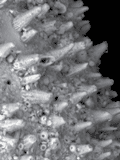 Abstract:
The ostracod associations of the Lower Pleistocene sedimentary succession cropping out at Serra San Biagio (Catania, Sicily NE) have been investigated. The ostracod fauna from nine samples is poorly diversified but well-preserved: A total of forty taxa of ostracods have been identified, thirty-three at specific level and seven at genus level or doubtful species. Thirty species are considered as constituents of the in situ original assemblages. The associations consist almost exclusively of bathyal taxa such as Bythocypris obtusata (Sars), Anchistrocheles antemacella Maddocks, Henryhowella ex H. hirta (Costa) group, Quasibuntonia radiatopora (Seguenza), Retibythere
(Bathybythere) scaberrima (Brady) and Bathycythere vansraateni Sissingh. Also the Krithe group is well-represented with Krithe compressa (Seguenza) and K. pernoides (Bornemann). Almost all species, some, particularly interesting from the palaeoecological and palaeogeographical point of view, have been here described, illustrated and commented on, including a species belonging to the genus Cytherella Jones,
1849, found in all samples of the section, which is here proposed as new. Abstract:
The ostracod associations of the Lower Pleistocene sedimentary succession cropping out at Serra San Biagio (Catania, Sicily NE) have been investigated. The ostracod fauna from nine samples is poorly diversified but well-preserved: A total of forty taxa of ostracods have been identified, thirty-three at specific level and seven at genus level or doubtful species. Thirty species are considered as constituents of the in situ original assemblages. The associations consist almost exclusively of bathyal taxa such as Bythocypris obtusata (Sars), Anchistrocheles antemacella Maddocks, Henryhowella ex H. hirta (Costa) group, Quasibuntonia radiatopora (Seguenza), Retibythere
(Bathybythere) scaberrima (Brady) and Bathycythere vansraateni Sissingh. Also the Krithe group is well-represented with Krithe compressa (Seguenza) and K. pernoides (Bornemann). Almost all species, some, particularly interesting from the palaeoecological and palaeogeographical point of view, have been here described, illustrated and commented on, including a species belonging to the genus Cytherella Jones,
1849, found in all samples of the section, which is here proposed as new.
|
|
Carnets Geol., vol. 15, no. 14, p. 179-197
Online since November 11, 2015
|
|
Review of some Aptian ammonites collected by Gaston Astre in Lleida Province, Catalonia, Spain
Josep A. MORENO-BEDMAR & Keith P. MINOR
| HTML  | PDF
| PDF  [934 KB]
| DOI:
10.4267/2042/56911
[934 KB]
| DOI:
10.4267/2042/56911
|
|
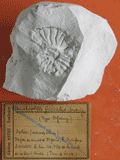 Abstract:
We study the three best preserved ammonites collected by Astre in 1924-1925 in Lleida Province, Catalonia, Spain, in order to assess their taxonomic assignment. We also include images of these ammonoids since they were not illustrated in Astre's original 1934 work. This taxonomic review allows us to identify these lower Aptian ammonites as Pseudohaploceras liptoviense, Deshayesites sp. and Dufrenoyia sp. Abstract:
We study the three best preserved ammonites collected by Astre in 1924-1925 in Lleida Province, Catalonia, Spain, in order to assess their taxonomic assignment. We also include images of these ammonoids since they were not illustrated in Astre's original 1934 work. This taxonomic review allows us to identify these lower Aptian ammonites as Pseudohaploceras liptoviense, Deshayesites sp. and Dufrenoyia sp.
|
|
Carnets Geol., vol. 15, no. 13, p. 173-178
Online since August 6, 2015
|
|
Sequence stratigraphic architecture of marine to fluvial deposits across a passive margin (Cenomanian, Atlantic margin, Morocco, Agadir transect)
Badre ESSAFRAOUI, Serge FERRY, Danièle GROSHÉNY, Nourrisaid IÇAME, Hassan EL AOULI, Moussa MASROUR, Luc G. BULOT, Yves GÉRAUD & Mohamed AOUTEM
| HTML  | PDF
| PDF  [24,372 KB]
| DOI:
10.4267/2042/56909
[24,372 KB]
| DOI:
10.4267/2042/56909
|
|
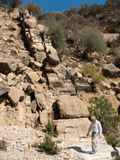 Abstract:
Seven sections, covering the upper Albian to lowermost Turonian, have been correlated from full-marine to continental-dominated deposits across a passive margin, along a transect 425 km long, from the present-day Atlantic coast to the "Pre-African Trough" between the Anti-Atlas and the High-Atlas. The thickness of the Cenomanian succession changes from around 500 metres in the fully marine sections to 250 metres in mostly continental facies in the western High-Atlas, about 150 km updip, to a few tens of metres in the Bou Tazoult area. The strata thicken again eastwards into the Pre-African Trough where they can be traced without major facies changes to the Kem Kem embayment and to the Bechar area in Algeria. Over all this eastern area, continental facies are overlain by the fully-marine shallow-water deposits of the Cenomanian-Turonian boundary interval. Abstract:
Seven sections, covering the upper Albian to lowermost Turonian, have been correlated from full-marine to continental-dominated deposits across a passive margin, along a transect 425 km long, from the present-day Atlantic coast to the "Pre-African Trough" between the Anti-Atlas and the High-Atlas. The thickness of the Cenomanian succession changes from around 500 metres in the fully marine sections to 250 metres in mostly continental facies in the western High-Atlas, about 150 km updip, to a few tens of metres in the Bou Tazoult area. The strata thicken again eastwards into the Pre-African Trough where they can be traced without major facies changes to the Kem Kem embayment and to the Bechar area in Algeria. Over all this eastern area, continental facies are overlain by the fully-marine shallow-water deposits of the Cenomanian-Turonian boundary interval.
A first major conclusion is that fluvial aggradation in high-frequency transgressive-regressive sequences is coeval with the seaward-shift of the shoreline, in accordance with the genetic sequence stratigraphic model of Galloway (1989). Both the flatness of the depositional profile and the corresponding very low energy of the marine environment during the transgressions account for the blanket of red continental clays on top of marine facies in updip depositional sequences, which is then preserved under the marine transgressive surface of the next sequence.
A second major conclusion is that the high-frequency transgressive-regressive (T-R) sequences do not look like classical parasequences bounded by transgression surfaces. They usually exhibit a surface created by a sea-level fall within the regressive half-cycle. This is interpreted in the following way: regressions did not operate through a regular seaward-shift of the shoreline, but through stepped sea-level falls. The very low slope of the depositional ramp is thought to have enhanced the sequence stratigraphic record of such stepped regressions. Short-term, high-frequency sequences are organized into medium-frequency T-R sequences (seven in the Cenomanian) which show an overall aggrading and slowly retrograding pattern along the whole transect.
Comparisons with other basins show that medium-frequency sequences do not fit
the third-order depositional sequences described elsewhere, casting doubts about
a eustatic mechanism for their deposition.
|
|
Carnets Geol., vol. 15, no. 12, p. 137-172
Online since August 6, 2015
|
|
End of a modern geological myth: there are no rudists in Brazil! Paleobiogeographic implications
Bruno GRANIER & Dimas DIAS-BRITO
| HTML  | PDF
| PDF  [1,631 KB]
| DOI:
10.4267/2042/56880
[1,631 KB]
| DOI:
10.4267/2042/56880
|
|
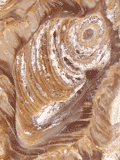 Abstract:
Out of the few records of rudists from the Cretaceous strata of the South Atlantic coastal
basins only two refer to Brazilian localities. However, petrographic analyses
demonstrate that these shells should be assigned to Ostreids or
to Pycnodontids rather than to Rudistids. More specifically, the domain considered herein, north of
the Río Grande Rise - Walvis Ridge barrier, was part of the warm-water
"tropical" realm, but it was not part of the Mesogean domain because both
Rudistids and Orbitolinas are missing. In addition, the scarcity of corals leads
us to ascribe the taphonomic assemblage to the Chloralgal facies. Neither
generalized hypersalinity or extreme sea-water temperatures seem to account for
these biotic peculiarities. Instead, our alternative hypothesis favors the
driving role played by oceanic circulation in the dispersal of the benthic organisms. Abstract:
Out of the few records of rudists from the Cretaceous strata of the South Atlantic coastal
basins only two refer to Brazilian localities. However, petrographic analyses
demonstrate that these shells should be assigned to Ostreids or
to Pycnodontids rather than to Rudistids. More specifically, the domain considered herein, north of
the Río Grande Rise - Walvis Ridge barrier, was part of the warm-water
"tropical" realm, but it was not part of the Mesogean domain because both
Rudistids and Orbitolinas are missing. In addition, the scarcity of corals leads
us to ascribe the taphonomic assemblage to the Chloralgal facies. Neither
generalized hypersalinity or extreme sea-water temperatures seem to account for
these biotic peculiarities. Instead, our alternative hypothesis favors the
driving role played by oceanic circulation in the dispersal of the benthic organisms.
|
|
Carnets Geol., vol. 15, no. 11, p. 123-136
Online since July 14, 2015
|
|
Facies, biostratigraphy, diagenesis, and depositional environments of Lower Cretaceous strata, Sierra San José section, Sonora (Mexico)
Jayagopal MADHAVARAJU, Robert W. SCOTT, Yong Il LEE, Kunjukrishnan Sathy BINCY, Carlos M. GONZÁLEZ-LEÓN & Sooriamuthu RAMASAMY
| HTML  | PDF
| PDF  [1,401 KB]
| DOI:
10.4267/2042/56879
[1,401 KB]
| DOI:
10.4267/2042/56879
|
|
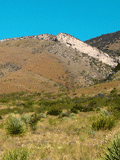 Abstract:
We used petrofacies analysis, carbon, oxygen and strontium isotope data to interpret the isotopic variations in the carbonate
rocks of the Mural Formation of Sonora (Sierra San José section), Mexico. The
petrographic study reveals a range of lithofacies from wackestone to packstone. The
analyzed limestones show significant negative δ18O values (-18.6 to -10.9 VPDB) and
δ13C values ranging from negative to positive (-2.6 to +2.5‰ VPDB). The absence of
correlation between δ13C and δ18O
values suggests a primary marine origin for the δ13C values of
limestones from the Sierra San José section. The limestones have large variations in 87Sr/86Sr
values (0.707479 to 0.708790). Higher 87Sr/86Sr ratios in
various levels of the studied section suggest that most of the sediments were
derived from the Proterozoic basement of the Caborca block during Early
Cretaceous time. A decrease in 87Sr/86Sr ratios at
certain levels indicates an influx of lesser amounts of radiogenic Sr that
could have been caused by contribution of sediments from the Triassic and Jurassic volcanic rocks. Abstract:
We used petrofacies analysis, carbon, oxygen and strontium isotope data to interpret the isotopic variations in the carbonate
rocks of the Mural Formation of Sonora (Sierra San José section), Mexico. The
petrographic study reveals a range of lithofacies from wackestone to packstone. The
analyzed limestones show significant negative δ18O values (-18.6 to -10.9 VPDB) and
δ13C values ranging from negative to positive (-2.6 to +2.5‰ VPDB). The absence of
correlation between δ13C and δ18O
values suggests a primary marine origin for the δ13C values of
limestones from the Sierra San José section. The limestones have large variations in 87Sr/86Sr
values (0.707479 to 0.708790). Higher 87Sr/86Sr ratios in
various levels of the studied section suggest that most of the sediments were
derived from the Proterozoic basement of the Caborca block during Early
Cretaceous time. A decrease in 87Sr/86Sr ratios at
certain levels indicates an influx of lesser amounts of radiogenic Sr that
could have been caused by contribution of sediments from the Triassic and Jurassic volcanic rocks.
|
|
Carnets Geol., vol. 15, no. 10, p. 103-122
Online since July 14, 2015
|
|
Cambrian fossils from the Barrandian area (Czech Republic) stored in the Musée d'Histoire Naturelle de Lille
Oldřich FATKA, Petr BUDIL, Catherine CRÔNIER, Jessie CUVELIER, Lukáš LAIBL, Thierry OUDOIRE, Marika POLECHOVÁ & Lucie FATKOVÁ
| HTML  | PDF
| PDF  [1,415 KB]
| DOI:
10.4267/2042/56878
[1,415 KB]
| DOI:
10.4267/2042/56878
|
|
 Abstract:
A complete list of fossils originating from the Cambrian of the Barrandian area
and housed in the Musée d'Histoire Naturelle de Lille is compiled. The
collection includes two agnostids, ten trilobites, one brachiopod and one
echinoderm species, all collected at ten outcrops in the Buchava Formation of
the Skryje-Týřovice Basin and most probably also
at two outcrops in the Jince Formation of the Příbram-Jince Basin. A large part of the material was
collected by Prof. Charles Barrois and Dr. Louis Dollé (both
University of Lille) during the excursion organised before the Ninth
International Geological Congress in Vienna in 1903. Other, poorly documented specimens were purchased from the
enterprise Krantz towards the end of the 19th century and in the
first years of 20th century. The geographic position and stratigraphy
of outcrops, from which the material originates, are briefly discussed. Abstract:
A complete list of fossils originating from the Cambrian of the Barrandian area
and housed in the Musée d'Histoire Naturelle de Lille is compiled. The
collection includes two agnostids, ten trilobites, one brachiopod and one
echinoderm species, all collected at ten outcrops in the Buchava Formation of
the Skryje-Týřovice Basin and most probably also
at two outcrops in the Jince Formation of the Příbram-Jince Basin. A large part of the material was
collected by Prof. Charles Barrois and Dr. Louis Dollé (both
University of Lille) during the excursion organised before the Ninth
International Geological Congress in Vienna in 1903. Other, poorly documented specimens were purchased from the
enterprise Krantz towards the end of the 19th century and in the
first years of 20th century. The geographic position and stratigraphy
of outcrops, from which the material originates, are briefly discussed.
|
|
Carnets Geol., vol. 15, no. 9, p. 89-101
Online since July 14, 2015
|
|
Lower Valanginian ammonite biostratigraphy in the Subbetic Domain (Betic Cordillera, southeastern Spain)
Miguel COMPANY & José M. TAVERA
| HTML  | PDF
| PDF  [1,459 KB]
| DOI:
10.4267/2042/56745
[1,459 KB]
| DOI:
10.4267/2042/56745
|
|
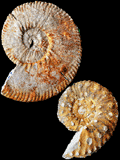 Abstract:
A new zonation for the lower Valanginian in the Betic Cordillera is presented. It is based on the study of 16 sections located near Caravaca and Cehegín (Region of Murcia).
From bottom to top, the following interval zones, defined by the first appearance of the index-species, are distinguished: Abstract:
A new zonation for the lower Valanginian in the Betic Cordillera is presented. It is based on the study of 16 sections located near Caravaca and Cehegín (Region of Murcia).
From bottom to top, the following interval zones, defined by the first appearance of the index-species, are distinguished:
● "Thurmanniceras" pertransiens Zone, which can be
subdivided into two subzones, a lower "Th." pertransiens Subzone and an upper
Vergoliceras salinarium Subzone. The latter is characterized by the disappearance of
Olcostephanus drumensis and the appearance of Luppovella superba.
● Neocomites neocomiensiformis Zone, also with two subzones, the Baronnites hirsutus Subzone below (characterized by the
appearance of "Busnardoites" subcampylotoxus and Olcostephanus
guebhardi) and the Valanginites dolioliformis Subzone above ("Busnardoites"
campylotoxus is restricted to this subzone).
● Karakaschiceras inostranzewi Zone, subdivided as well into two subzones, a lower
Karakaschiceras inostranzewi Subzone and an upper Saynoceras contestanum Subzone.
The assemblages characterizing each of these biozones can be recognized throughout the Mediterranean region.
|
|
Carnets Geol., vol. 15, no. 8, p. 71-88
Online since June 11, 2015
|
|
Some encrusted hardgrounds from the Ordovician of Estonia (Baltica)
Olev VINN & Ursula TOOM
| HTML  | PDF
| PDF  [344 KB]
| DOI:
10.4267/2042/56744
[344 KB]
| DOI:
10.4267/2042/56744
|
|
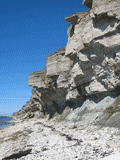 Abstract:
The Ordovician hardground faunas of Estonia are not diverse. They include echinoderm holdfasts (i.e., eocrinoids and crinoids), edrioasteroids, bryozoans (both hemispherical
trepostomes and stalked ptilodictyids) and cornulitids. The earliest hardground faunas appeared in the Dapingian (i.e., bryozoans and echinoderms). The Estonian hardground
faunas are less diverse than the North American ones. North American hardgrounds seem to be more heavily encrusted than the Estonian ones. These differences may be due to
the paleogeographic distances, different climates and different sedimentation environments of the paleocontinents. Abstract:
The Ordovician hardground faunas of Estonia are not diverse. They include echinoderm holdfasts (i.e., eocrinoids and crinoids), edrioasteroids, bryozoans (both hemispherical
trepostomes and stalked ptilodictyids) and cornulitids. The earliest hardground faunas appeared in the Dapingian (i.e., bryozoans and echinoderms). The Estonian hardground
faunas are less diverse than the North American ones. North American hardgrounds seem to be more heavily encrusted than the Estonian ones. These differences may be due to
the paleogeographic distances, different climates and different sedimentation environments of the paleocontinents.
|
|
Carnets Geol., vol. 15, no. 7, p. 63-70
Online since June 11, 2015
|
|
MayLib - a textfile-based bibliographic database for geosciences and a list of references on Devonian matters
Andreas MAY
| HTML  | PDF
| PDF  [420 KB]
| DOI:
10.4267/2042/56481 [420 KB]
| DOI:
10.4267/2042/56481
|
|
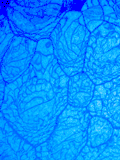 Abstract: Scientists need to manage their own collections of bibliographic data as well as exchange these data easily with
colleagues. One solution for this need is MayLib, a bibliographic database that runs on many different operating systems and does not require pre-installation of any software. MayLib is a very
small, efficient and comprehensive JAVA program that handles references to publications in
any Unicode-compatible language. It is user-friendly and not only contains the basic functions of a bibliographic
database, but also has some advanced features. Using MayLib the author has been able to create a list of references, which contains 500 periodicals and 4206 literature
references. Of these 4206 references 3191 deal with Devonian matters and 1594 references deal with corals. Abstract: Scientists need to manage their own collections of bibliographic data as well as exchange these data easily with
colleagues. One solution for this need is MayLib, a bibliographic database that runs on many different operating systems and does not require pre-installation of any software. MayLib is a very
small, efficient and comprehensive JAVA program that handles references to publications in
any Unicode-compatible language. It is user-friendly and not only contains the basic functions of a bibliographic
database, but also has some advanced features. Using MayLib the author has been able to create a list of references, which contains 500 periodicals and 4206 literature
references. Of these 4206 references 3191 deal with Devonian matters and 1594 references deal with corals.
|
|
Carnets Geol., vol. 15, no. 6, p. 59-62
Online since March 9, 2015
|
|
New faunistic data on the Pleistocene environmental evolution of the south-western edge of the Hyblean Plateau (SE Sicily)
Francesco SCIUTO, Antonietta ROSSO, Rossana SANFILIPPO & Rossana MANISCALCO
| HTML  | PDF
| PDF  [2,810 KB]
| DOI:
10.4267/2042/56401 [2,810 KB]
| DOI:
10.4267/2042/56401
|
|
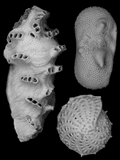 Abstract: Faunistic associations of the Lower Pleistocene sediments, out-cropping at
Cartiera Molino along the true right bank of the Ippari River (Vittoria, SE
Sicily), have been investigated. This
study integrates data obtained from the analysis of
ostracods, foraminifers, bryozoans and serpulids found within a
six metre thick sedimentary section. This multiproxy approach
allowed us to reconstruct the palaeoenvironmental evolution of this
south-western sector of the Hyblean Plateau (Comiso-Vittoria area) from
fluvially-influenced shallow marine settings, recorded in the lower portion of
the succession, to progressively shallower, transitional and brackish
environments, testified in mid levels, up to freshwater environments at the top
of the section. Abstract: Faunistic associations of the Lower Pleistocene sediments, out-cropping at
Cartiera Molino along the true right bank of the Ippari River (Vittoria, SE
Sicily), have been investigated. This
study integrates data obtained from the analysis of
ostracods, foraminifers, bryozoans and serpulids found within a
six metre thick sedimentary section. This multiproxy approach
allowed us to reconstruct the palaeoenvironmental evolution of this
south-western sector of the Hyblean Plateau (Comiso-Vittoria area) from
fluvially-influenced shallow marine settings, recorded in the lower portion of
the succession, to progressively shallower, transitional and brackish
environments, testified in mid levels, up to freshwater environments at the top
of the section.
|
|
Carnets Geol., vol. 15, no. 5, p. 41-57
Online since February 28, 2015
|
|
A reassessment of the validity and affinities of Belemnites sulcatus Miller, 1826, Belemnopsis Edwards in Gray, 1849, and Belemnopsis Bayle, 1878
Simon F. MITCHELL
| HTML  | PDF
| PDF  [172 KB]
| DOI: 10.4267/2042/56399 [172 KB]
| DOI: 10.4267/2042/56399
|
|
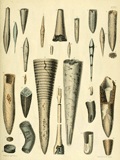 Abstract: A reinvestigation of the validity of the belemnite genus Belemnopsis Bayle is undertaken, together with a survey of the early history of the usage of the
names Belemnites sulcatus, Belemnopsis
Bayle and Belemnopsis Edwards.
Belemnites sulcatus Miller has been variously equated with either Belemnites
apiciconus Blainville or with the group of belemnites including
Belemnites Altdorfensis Blainville and B. Beaumontianus Orbigny. Riegraf (and not Phillips) subsequently designated a lectotype which may be
valid and, in case it is not, is validated here. The species concept for Belemnites
sulcatus, as based on this lectotype, places it in the genus Holcobeloides
Gustomesov. Belemnopsis Edwards has date priority over Belemnopsis Bayle, but must be interpreted
as an "incorrect original spelling" and, therefore, does not enter into homonymy according to the ICZN; Belemnopsis Bayle is thus a valid
genus. Douvillé subsequently nominated Belemnites sulcatus, which was figured as Belemnopsis sulcata by Bayle, and therefore is a valid designation because this species is
amongst the original species included in Belemnopsis by Bayle.
One of Bayle's figures of Belemnopsis
sulcata agrees with Belemnites apiciconus Blainville, but does not agree with Belemnites sulcatus as defined by its lectotype; as such this is a case of
misidentified type species. Belemnites apiciconus Blainville, the species involved in the misidentification,
is therefore designated type species of Belemnopsis Bayle here
and validated by citing the ICZN. The actions taken here maintain nomenclature
at the genus, family and suborder level in respect to the names Belemnopsis and Belemnosis and serve to stabilize the complicated nomenclature issues related to these taxa. Abstract: A reinvestigation of the validity of the belemnite genus Belemnopsis Bayle is undertaken, together with a survey of the early history of the usage of the
names Belemnites sulcatus, Belemnopsis
Bayle and Belemnopsis Edwards.
Belemnites sulcatus Miller has been variously equated with either Belemnites
apiciconus Blainville or with the group of belemnites including
Belemnites Altdorfensis Blainville and B. Beaumontianus Orbigny. Riegraf (and not Phillips) subsequently designated a lectotype which may be
valid and, in case it is not, is validated here. The species concept for Belemnites
sulcatus, as based on this lectotype, places it in the genus Holcobeloides
Gustomesov. Belemnopsis Edwards has date priority over Belemnopsis Bayle, but must be interpreted
as an "incorrect original spelling" and, therefore, does not enter into homonymy according to the ICZN; Belemnopsis Bayle is thus a valid
genus. Douvillé subsequently nominated Belemnites sulcatus, which was figured as Belemnopsis sulcata by Bayle, and therefore is a valid designation because this species is
amongst the original species included in Belemnopsis by Bayle.
One of Bayle's figures of Belemnopsis
sulcata agrees with Belemnites apiciconus Blainville, but does not agree with Belemnites sulcatus as defined by its lectotype; as such this is a case of
misidentified type species. Belemnites apiciconus Blainville, the species involved in the misidentification,
is therefore designated type species of Belemnopsis Bayle here
and validated by citing the ICZN. The actions taken here maintain nomenclature
at the genus, family and suborder level in respect to the names Belemnopsis and Belemnosis and serve to stabilize the complicated nomenclature issues related to these taxa.
|
|
Carnets Geol., vol. 15, no. 4, p. 31-39
Online since February 28, 2015
|
|
Earliest Aptian Caprinidae (Bivalvia, Hippuritida) from Lebanon
Jean-Pierre MASSE, Sibelle MAKSOUD, Mukerrem FENERCI-MASSE, Bruno GRANIER & Dany AZAR
| HTML  | PDF
| PDF  [1,585 KB]
| DOI: 10.4267/2042/56397 [1,585 KB]
| DOI: 10.4267/2042/56397
|
|
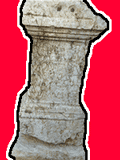 Abstract: The presence in Lebanon of Offneria murgensis and Offneria
nicolinae, two characteristic components of the Early Aptian Arabo-African
rudist faunas, fills a distributional gap of the corresponding assemblage
between the Arabic and African occurrences, on the one hand, and the Apulian
occurrences, on the other hand. This fauna bears out the palaeogeographic
placement of Lebanon on the southern Mediterranean Tethys margin established by
palaeostructural reconstructions. The associated micropaleontological elements
suggest an earliest Aptian age (early
Bedoulian) for the Offneria
murgensis - O. nicolinae assemblage
found in the "Falaise de Blanche"
stratigraphic interval, instead of a late Early Aptian age as proposed for most
of the peri-Adriatic and Middle East occurrences recognized so far. These
caprinid specimens are characterized by relatively modest sizes, moreover other
rudists commonly part of the assemblage are lacking. The dominance of caprinids
in the study area suggests a distal platform setting, i.e., close
proximity to the platform edge. Abstract: The presence in Lebanon of Offneria murgensis and Offneria
nicolinae, two characteristic components of the Early Aptian Arabo-African
rudist faunas, fills a distributional gap of the corresponding assemblage
between the Arabic and African occurrences, on the one hand, and the Apulian
occurrences, on the other hand. This fauna bears out the palaeogeographic
placement of Lebanon on the southern Mediterranean Tethys margin established by
palaeostructural reconstructions. The associated micropaleontological elements
suggest an earliest Aptian age (early
Bedoulian) for the Offneria
murgensis - O. nicolinae assemblage
found in the "Falaise de Blanche"
stratigraphic interval, instead of a late Early Aptian age as proposed for most
of the peri-Adriatic and Middle East occurrences recognized so far. These
caprinid specimens are characterized by relatively modest sizes, moreover other
rudists commonly part of the assemblage are lacking. The dominance of caprinids
in the study area suggests a distal platform setting, i.e., close
proximity to the platform edge.
|
|
Carnets Geol., vol. 15, no. 3, p. 21-30
Online since February 15, 2015
|
|
Simple and practical techniques to manage small databases, illustrated
by a case study: bibliographic data from the "Fossil Cnidaria & Porifera" newsletter (1972-2010)
Katarzyna ZALECKA, Tomasz WRZOŁEK & Bruno GRANIER
| HTML  | PDF
| PDF  [342 KB]
| DOI: 10.4267/2042/56249 [342 KB]
| DOI: 10.4267/2042/56249
|
|
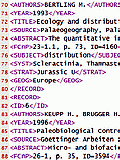 Abstract: Small databases, i.e., with less than 15,000 entries, are
sometimes handled using
inappropriate, complex, and often expensive data management systems. We
present and briefly discuss a few types of proprietary and open-source,
relational and non-relational, server-based versus portable databases and
specific tools to handle the latter. With a collection of nearly
7,000 bibliographic notes during its 40-year history "Fossil Cnidaria &
Porifera (FC&P)", the newsletter of the "International Association for Study
of Fossil Cnidaria and Porifera", was chosen as a case study. The analysis of the
temporal trends in the FC&P bibliographic database shows a decrease over the
years in the number of publications effectively reported in FC&P. Almost all
relevant papers for the decade 1981-1990 are reported, but this good
coverage ratio falls down to less than 50% after 2000; accordingly, the concern about the
data representativeness is addressed in our interpretation. Besides the classical
database management systems and spreadsheet software, which were originally used
with the FC&P case study, we present two discrete,
open-source, flat and portable options where data can be displayed using any
widely available Internet browser, and that are suitable to handle most small
databases (XML or JS files) as documented herein. Abstract: Small databases, i.e., with less than 15,000 entries, are
sometimes handled using
inappropriate, complex, and often expensive data management systems. We
present and briefly discuss a few types of proprietary and open-source,
relational and non-relational, server-based versus portable databases and
specific tools to handle the latter. With a collection of nearly
7,000 bibliographic notes during its 40-year history "Fossil Cnidaria &
Porifera (FC&P)", the newsletter of the "International Association for Study
of Fossil Cnidaria and Porifera", was chosen as a case study. The analysis of the
temporal trends in the FC&P bibliographic database shows a decrease over the
years in the number of publications effectively reported in FC&P. Almost all
relevant papers for the decade 1981-1990 are reported, but this good
coverage ratio falls down to less than 50% after 2000; accordingly, the concern about the
data representativeness is addressed in our interpretation. Besides the classical
database management systems and spreadsheet software, which were originally used
with the FC&P case study, we present two discrete,
open-source, flat and portable options where data can be displayed using any
widely available Internet browser, and that are suitable to handle most small
databases (XML or JS files) as documented herein.
|
|
Carnets Geol., vol. 15, no. 2, p. 13-19
Online since January 14, 2015
|
|
Lower Aptian ammonites of the Sierra de Parras, Coahuila State, northern Mexico
José R. OVANDO-FIGUEROA, Josep A. MORENO-BEDMAR Gabriel, CHÁVEZ-CABELLO & Keith P. MINOR
| HTML  | PDF
| PDF  [2,356 KB]
| DOI: 10.4267/2042/56250 [2,356 KB]
| DOI: 10.4267/2042/56250
|
|
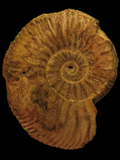 Abstract: We report an
interesting Aptian ammonite record from the La Peña Formation in the Sierra de
Parras, Coahuila State. This assemblage is analyzed from a paleoecological
perspective. It contains the first reported occurrence of a macroconch of Dufrenoyia
from Mexico, and the largest known specimen of 'Gargasiceras'
adkinsi. Such an assemblage yielding
large ammonites is unusual in deposits of this age in Mexico. To properly
document this ammonite record, we review 'Gargasiceras'
adkinsi, formerly misidentified as Rhytidoplites
robertsi, and allied taxa. From our analysis, we conclude that 'Gargasiceras'
adkinsi exhibits strong intraspecific
variability. We also analyze in detail the differences that exist between 'Gargasiceras'
adkinsi and Rhytidoplites
robertsi, and emend the concept of the genus Rhytidoplites. These revisions are important from a biostratigraphic
point of view since 'Gargasiceras'
adkinsi is an index species for the
lower Aptian ammonite zonation of Mexico. Abstract: We report an
interesting Aptian ammonite record from the La Peña Formation in the Sierra de
Parras, Coahuila State. This assemblage is analyzed from a paleoecological
perspective. It contains the first reported occurrence of a macroconch of Dufrenoyia
from Mexico, and the largest known specimen of 'Gargasiceras'
adkinsi. Such an assemblage yielding
large ammonites is unusual in deposits of this age in Mexico. To properly
document this ammonite record, we review 'Gargasiceras'
adkinsi, formerly misidentified as Rhytidoplites
robertsi, and allied taxa. From our analysis, we conclude that 'Gargasiceras'
adkinsi exhibits strong intraspecific
variability. We also analyze in detail the differences that exist between 'Gargasiceras'
adkinsi and Rhytidoplites
robertsi, and emend the concept of the genus Rhytidoplites. These revisions are important from a biostratigraphic
point of view since 'Gargasiceras'
adkinsi is an index species for the
lower Aptian ammonite zonation of Mexico.
|
|
Carnets Geol., vol. 15, no. 1, p. 1-11
Online since January 14, 2015
|
|
|
|